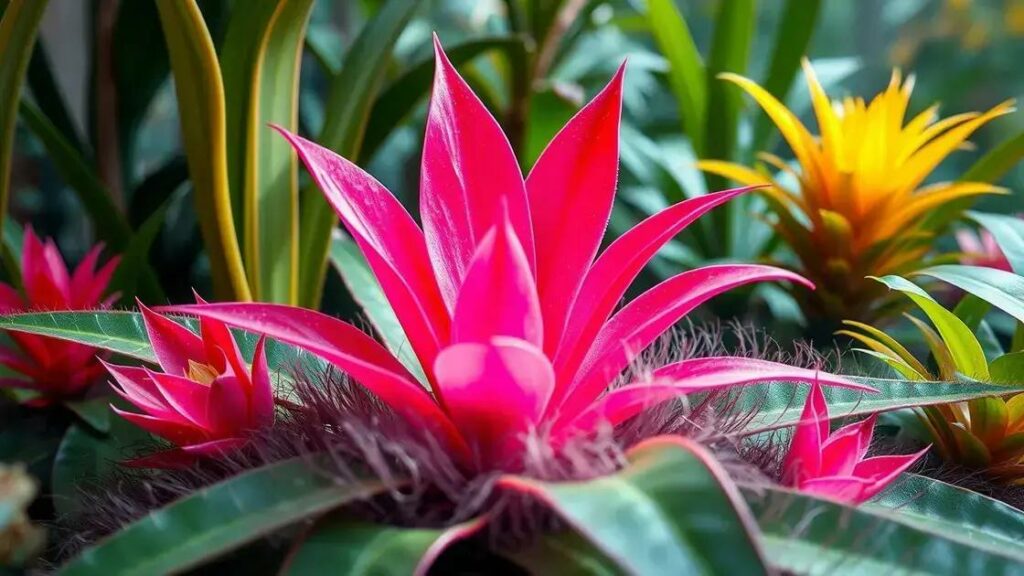How to care for bromeliads plant can feel overwhelming to many new plant lovers. With their unique beauty and vibrant colors, these tropical plants deserve special attention. You’ll discover the essentials of watering, light requirements, and pest management that guarantee a thriving bromeliad in your home. Let’s dive into the wonderful world of bromeliad care!
Table of Contents
ToggleUnderstanding bromeliad plant watering needs
Understanding bromeliad plant watering needs is essential for maintaining healthy and vibrant plants. Proper watering techniques can greatly enhance the growth and bloom of your bromeliads. This section will guide you through the necessary steps to ensure your bromeliads receive the right amount of water without the risk of overwatering.
Watering bromeliads in their natural habitat
Bromeliads are native to tropical regions where they naturally collect rainwater. Therefore, replicating these conditions at home is vital. Here are a few key points to consider:
- In their natural environment, bromeliads thrive on filtered water.
- They often hold water in their leaf axils (the space between the leaves).
- Too much standing water can lead to root rot.
How often to water your bromeliads
The frequency of watering largely depends on the environment. Factors such as humidity, temperature, and season play a crucial role. Below are general guidelines:
- During growing season (spring and summer): Water every week.
- In fall and winter: Reduce watering to every two weeks.
- Always check the soil moisture; the top inch should be dry before watering again.
Best practices for bromeliad plant watering
To ensure you are meeting your bromeliad’s watering needs, consider these best practices:
- Water early in the morning to allow excess moisture to evaporate during the day.
- Avoid using tap water high in chlorine; filtered or distilled water is preferable.
- Fill the cup formed by the leaves with water, checking to top it off regularly without overflowing.
Common mistakes in bromeliad watering
Avoid these common errors to keep your bromeliads healthy:
- Overwatering: Always allow the soil to dry out slightly.
- Using cold water: Room temperature water is best.
- Ignoring humidity levels: Ensure your indoor environment has adequate moisture.
In summary, understanding bromeliad plant watering needs involves mimicking their natural habitat and being mindful of environmental conditions. For those looking to expand their gardening knowledge, consider exploring indoor gardening techniques to optimize care for your lush collection.
Fertilizing bromeliads for optimal growth

Fertilizing bromeliads for optimal growth is crucial for maintaining their health and vibrant blooms. These unique plants benefit from proper nutrient application, enhancing their natural beauty and resilience.
What type of fertilizer is best for bromeliads?
Choosing the right fertilizer is vital for the health of your bromeliads. Here are some recommended types:
- Balanced fertilizers (such as 10-10-10) are suitable for general feeding.
- Slow-release granular fertilizers provide consistent nutrients over time.
- Liquid fertilizers can be applied more frequently for immediate effects.
When to fertilize your bromeliads
Timing is key when fertilizing bromeliads. Follow these guidelines:
- During active growing phases (spring and summer), fertilize every 4-6 weeks.
- In fall and winter, reduce feeding to once every two months or refrain entirely.
- Always check the specific needs of your bromeliad species.
How to apply fertilizer effectively
Proper application of fertilizer enhances absorption and prevents damage. Consider these tips:
- Dilute liquid fertilizers to half the strength for bromeliads.
- Apply fertilizers directly to the soil or around the base of the plant.
- Avoid getting fertilizer on the leaves to prevent burns.
Signs of over-fertilization
Recognizing the signs of over-fertilization can save your bromeliads from harm:
- Brown leaf tips indicate excess salts in the soil.
- Yellowing leaves may signal nutrient imbalance.
- Wilting or drooping can occur due to root stress.
In conclusion, fertilizing bromeliads for optimal growth involves using the right types of fertilizers and timing applications appropriately. For further guidance on caring for your bromeliads, consider exploring indoor gardening techniques that enhance your gardening experience.
Common pests and how to protect your bromeliads
Common pests and how to protect your bromeliads can significantly affect the health of these beautiful plants. Managing pests effectively ensures that your bromeliads thrive and remain visually stunning in your indoor space. Let’s explore the most prevalent pests and how to safeguard your plants against them.
Identifying common pests on bromeliads
Awareness of common pests is the first step in prevention:
- Mealybugs: Small, white, cottony insects often found in leaf axils.
- Spider mites: Tiny spiders that create fine webs and cause leaf discoloration.
- Scale insects: Hard, shell-like pests that can be green or brown, typically found on stems.
- Fungus gnats: Small flies that infest the soil and can damage roots.
Signs of pest infestations
Look out for these signs to catch infestations early:
- Sticky leaves: Indicating honeydew secreted by sap-sucking pests.
- Yellowing or wilting leaves: Signs of stress on the plant.
- Pest webs: Especially from spider mites, which may cover leaf surfaces.
Effective pest control methods
To protect your bromeliads from these common pests, consider these practices:
- Regularly inspect your plants for signs of pests.
- Keep the leaves clean by wiping them with a damp cloth to deter insects.
- Use insecticidal soap or neem oil to treat infestations when detected.
- Introduce beneficial insects, such as ladybugs, that prey on harmful pests.
Preventive measures for healthy bromeliads
In addition to controlling pests, adopting preventive measures can enhance your bromeliads’ resilience:
- Maintain proper watering practices to avoid attracting pests.
- Ensure good air circulation around your plants to reduce humidity levels that pests thrive in.
- Quarantine new plants before introducing them to your collection to prevent infestations.
By understanding common pests and how to protect your bromeliads, you can keep your plants healthy and robust. For further assistance with indoor gardening, consider exploring indoor gardening techniques to elevate your plant care regimen.
In conclusion
Caring for bromeliads requires understanding their specific needs, including watering, fertilization, and protection from pests. By following the essential tips outlined in this guide, you can ensure your bromeliads thrive and bring vibrant beauty to your indoor space. Remember, each plant is unique, and observing their behavior is key to successful care. For additional insights, consider checking out tips on enhancing your indoor garden to further enrich your gardening journey.

